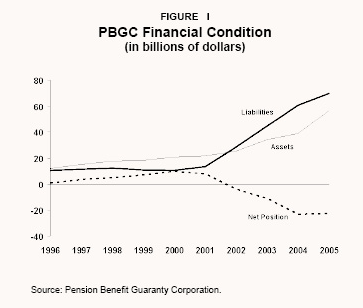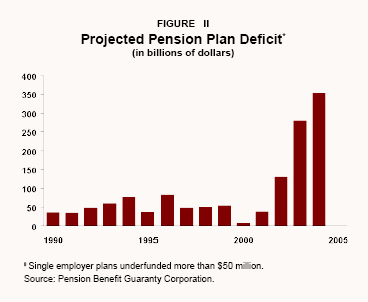America 's defined benefit pension plans are in crisis. Traditional defined benefit (DB) pensions are usually paid to retired employees based on years of work and final salary. Although still common at large companies, they have fallen out of favor at small and mid-sized firms. Virtually no new DB plans have been created in the last 10 years. Once the Cadillac of retirement plans, they are now the Edsels of employee benefits, as employers shift to defined contribution (DC) plans, such as 401(k)s.

The majority of existing DB plans are significantly underfunded. The crisis stems from the growing number of retirees receiving DB pensions and the growing number of companies forced into bankruptcy due to benefit costs. When companies default on their obligations, workers receive benefits from the federal Pension Benefit Guaranty Corporation (PBGC).
The number of companies already or potentially in default threaten the PBGC's solvency. Although the PBGC is funded through a tax on employers who sponsor DB plans, there is growing concern that taxpayers will eventually pick up the tab.
Genesis of the PBGC. The federal government created the PBGC in 1974 to guarantee future retirees' benefits after the Studebaker bankruptcy left over 4,000 retired workers with just 15 cents on every dollar they had been promised.
The PBGC's current estimated liabilities are $24 billion greater than its assets, as shown in Figure I. Looking forward, the Congressional Budget Office projects the PBGC's current plus future net deficit will total $87 billion, based on companies deemed likely to default. Pension plans that are paying their current obligations but do not have adequate assets to meet all future obligations are underfunded by $450 billion. [See Figure II.]
The Crisis. The proximate trigger for the current crisis is a string of major bankruptcies by companies with underfunded plans, including Delphi and several airlines. But the problem has deeper roots: built-in incentives for corporations to underfund their pension plans.

The law requires companies to put aside funds to meet their promises to workers, but the law lacks teeth. For instance, companies can average their investment results so they have years to make up bad stock market returns. DB plans mostly pay a fixed tax per employee, meaning workers entitled to the maximum guaranteed annual pension of $38,000 cost as much as workers entitled to less than $10,000. Although severely underfunded plans must pay a penalty tax, it is trivial. A company underfunded by $5 million faces an extra tax of just $45,000. As a result, companies leave their pension plans severely underfunded for many years.
The government also taxes excess contributions to limit companies' tax deductions. Thus companies that fall behind cannot fully fund their pensions without incurring penalties.
Furthermore, PBGC's definition of the funding needed is severely flawed. For example, when Bethlehem Steel went bankrupt, its pension plan was 84 percent fully funded according to PBGC definitions. The plan's assets, though, covered only 45 percent of its actual liabilities.
Defined Benefit Plans Are Risky. Diversification is the key to safe investing, but DB plans are backed by the assets of only one company – the employer – which is like a 401(k) entirely invested in one company's bonds.
DB plans are inherently more risky than DC plans. For example, employees own 401(k) funds, whereas DB plans only promise them future pension payments. Employees with 401(k)s face the risks of market fluctuations, but workers with DB pensions face risks related to the management and fiscal health of their employer. Furthermore, DB plans are "back-end loaded," meaning that the greatest gain to the employee occurs near the end of her career. If she is laid off or quits before retirement age, she is worse off than if she had a 401(k) plan, which is portable and not dependent on her employer's financial health.
The PBGC Is Risky. The PBGC lowers employees' risk by shifting it to other employers and, ultimately, to taxpayers. Although PBGC does not have a formal claim on general tax revenue, Congress is widely expected to spend tax money when the PBGC runs out of assets – just as it bailed out savings and loans in the 1980s.
The DB system is permeated with political risk, since funding requirements are set by law. Many reforms have been proposed to improve PBGC's fiscal health, including moving to an insurance-like structure that would charge riskier plans a higher tax rate, and increase the rate at which companies must add money to underfunded plans. However, Congress listens to corporate lobbyists more than to actuaries. It has granted special relief to the airline and steel industries, and continues to listen to companies that want to slow the pace of required pension funding.
Private Insurance Can Replace the PBGC. Today, a company that wants to voluntarily terminate a DB plan purchases private insurance. The company pays a highly rated insurance company to assume its pension obligations. It would be a small step to require all DB plans to buy private insurance to guarantee benefits instead of relying on the PBGC. Competing insurance companies would review the actuarial analysis of the plan and its investments, and price their insurance accordingly. Insurance would be fairly cheap for fully funded plans with solid investments. Insurance would be very expensive for severely underfunded plans. However, expensive insurance merely reflects high intrinsic risk – risk now being shifted onto other employers and taxpayers. During the transition, PBGC must keep collecting taxes from companies with pension plans to meet their existing claims, but no new obligations should be taken on by this bankrupt agency.
Time for a Change. The present crisis shows that DB plans are risky and the PBGC is fundamentally unsound. Employers are already making the transition to DC plans voluntarily. A transition from PBGC to private insurance will put employee pension benefits on a sound footing, while eliminating risk to taxpayers.
William B. Conerly, Ph.D. is Principal of Conerly Consulting LLC and senior fellow at the National Center for Policy Analysis.